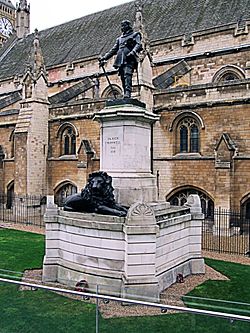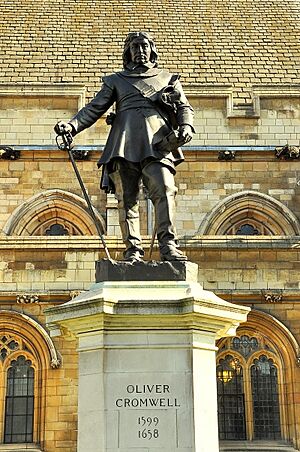Statue of Oliver Cromwell, Westminster facts for kids
Quick facts for kids Oliver Cromwell |
|
|---|---|
 |
|
| Year | 1899 |
| Type | Statue |
| Medium | |
| Subject | Oliver Cromwell |
| Location | London, SW1 United Kingdom |
| 51°29′59″N 0°07′33″W / 51.499788°N 0.125834°W | |
A statue of Oliver Cromwell stands outside the House of Commons of the United Kingdom in Westminster, London. Oliver Cromwell was a very important leader. He was the Lord Protector of England, Scotland, and Ireland from 1653 to 1658. This means he ruled the country.
Right across the road from the statue, on the wall of St Margaret's Church, there is a small statue of King Charles I. People often don't notice it.
The statue was made by Hamo Thornycroft. It was put up in 1899. Many people have had different opinions about it. This is because Cromwell was against the idea of kings and queens. He also played a big part in the conquest of Ireland.
This statue is one of only five public statues of Cromwell in the United Kingdom. It is a Grade II listed building. This means it is an important historical structure.
What the Statue Looks Like
The artist Hamo Thornycroft sculpted this statue. It shows Cromwell standing tall. He is holding a sword in one hand. In his other hand, he holds a bible.
The bible has "Holy Bible 1641" written on it. The main statue of Cromwell says "Hamo Thornycroft 1897". The lion at the bottom of the statue is marked "1899".
The Story Behind the Statue
After a fire damaged parts of the Palace of Westminster in the 1800s, people started talking. They wondered if Oliver Cromwell should have a statue there. Newspapers like The Times and Punch magazine wrote about it.
In 1856, the idea was brought up in the House of Commons. Some people strongly supported a statue for Cromwell. They said it would be wrong to object to it. The idea was discussed many times over the years.
In 1895, the government officially suggested a statue. This caused a lot of debate. People had very different feelings about Cromwell. The idea led to a vote in Parliament. The government almost lost the vote. Many members of the Conservative Party and Irish Nationalists voted against it. They remembered Cromwell's actions in Ireland. Newspapers in Ireland were also very unhappy.
Because of all the opposition, the plan was stopped on July 17, 1895. But then, Herbert Gladstone, a government official, approved the statue. An unknown person paid for it. In 1899, the statue's location was confirmed. It would be in the garden next to Westminster Hall.
The statue was officially revealed on October 31, 1899. After the unveiling, former Prime Minister Lord Rosebery gave a speech about Cromwell. Later, it was revealed that Lord Rosebery was the secret donor who paid for the statue!
In 2004, some Members of Parliament suggested removing the statue. They even wanted to melt it down. But this idea did not get enough support. Other MPs suggested moving it to a different place. The statue stayed where it was.
In August 2008, the statue was cleaned and repaired. Workers removed dirt and an old black wax coating. This changed the statue's color from black to a natural brown. They added a special chemical to make the color even. Then, they put a clear wax on it to protect it. The work was finished just in time for the 350th anniversary of Cromwell's death.
See also
 In Spanish: Estatua de Oliver Cromwell (Westminster) para niños
In Spanish: Estatua de Oliver Cromwell (Westminster) para niños


